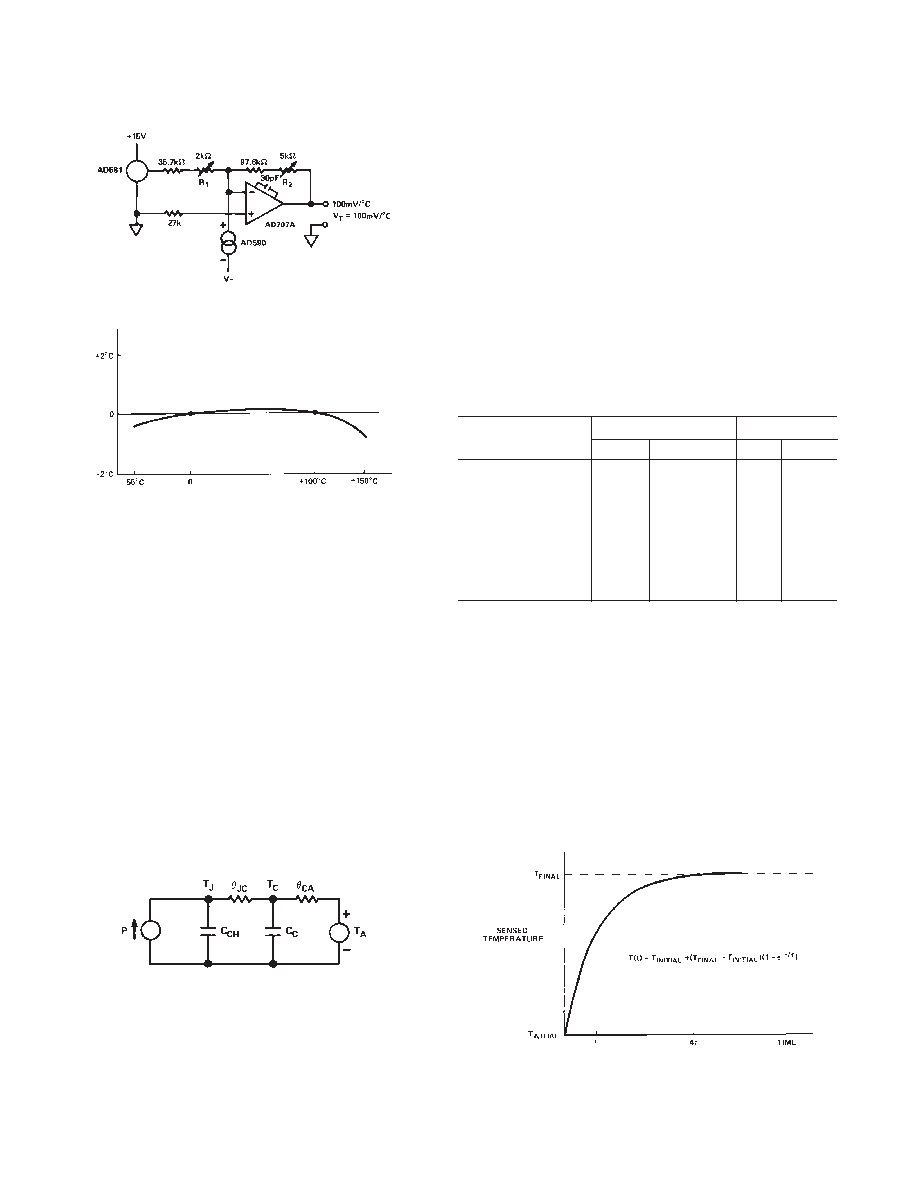- 您現(xiàn)在的位置:買賣IC網(wǎng) > PDF目錄24691 > 05F7081 IC-TEMPERATURE TRANSDUCER PDF資料下載
參數(shù)資料
| 型號: | 05F7081 |
| 英文描述: | IC-TEMPERATURE TRANSDUCER |
| 中文描述: | 集成電路溫度傳感器 |
| 文件頁數(shù): | 9/12頁 |
| 文件大?。?/td> | 168K |
| 代理商: | 05F7081 |

AD590
–6–
REV. B
Figure 7A. Two Temperature Trim
Figure 7B. Typical Two-Trim Accuracy
VOLTAGE AND THERMAL ENVIRONMENT EFFECTS
The power supply rejection specifications show the maximum
expected change in output current versus input voltage changes.
The insensitivity of the output to input voltage allows the use of
unregulated supplies. It also means that hundreds of ohms of
resistance (such as a CMOS multiplexer) can be tolerated in
series with the device.
It is important to note that using a supply voltage other than 5 V
does not change the PTAT nature of the AD590. In other
words, this change is equivalent to a calibration error and can be
removed by the scale factor trim (see previous page).
The AD590 specifications are guaranteed for use in a low thermal
resistance environment with 5 V across the sensor. Large
changes in the thermal resistance of the sensor’s environment
will change the amount of self-heating and result in changes in
the output which are predictable but not necessarily desirable.
The thermal environment in which the AD590 is used deter-
mines two important characteristics: the effect of self heating
and the response of the sensor with time.
Figure 8. Thermal Circuit Model
Figure 8 is a model of the AD590 which demonstrates these
characteristics. As an example, for the TO-52 package,
θ
JC is
the thermal resistance between the chip and the case, about
26
°C/watt. θ
CA is the thermal resistance between the case and
the surroundings and is determined by the characteristics of the
thermal connection. Power source P represents the power
dissipated on the chip. The rise of the junction temperature, TJ,
above the ambient temperature TA is:
T
J T A = P (θ JC +θCA )
Equation 1
Table I gives the sum of
θ
JC and
θ
CA for several common
thermal media for both the “H” and “F” packages. The heatsink
used was a common clip-on. Using Equation 1, the temperature
rise of an AD590 “H” package in a stirred bath at +25
°C, when
driven with a 5 V supply, will be 0.06
°C. However, for the same
conditions in still air the temperature rise is 0.72
°C. For a given
supply voltage, the temperature rise varies with the current and
is PTAT. Therefore, if an application circuit is trimmed with
the sensor in the same thermal environment in which it will be
used, the scale factor trim compensates for this effect over the
entire temperature range.
Table I. Thermal Resistances
Medium
θ
JC +
θ
CA ( C/Watt)
τ (sec)(Note 3)
HF
H
F
Aluminum Block
30
10
0.6
0.1
Stirred Oil1
42
60
1.4
0.6
Moving Air
2
With Heat Sink
45
–
5.0
–
Without Heat Sink
115
190
13.5
10.0
Still Air
With Heat Sink
191
–
108
–
Without Heat Sink
480
650
60
30
1Note:
τ is dependent upon velocity of oil; average of several velocities listed
above.
2Air velocity
9 ft./sec.
3The time constant is defined as the time required to reach 63.2% of an
instantaneous temperature change.
The time response of the AD590 to a step change in tempera-
ture is determined by the thermal resistances and the thermal
capacities of the chip, CCH, and the case, CC. CCH is about
0.04 watt-sec/
°C for the AD590. C
C varies with the measured
medium since it includes anything that is in direct thermal
contact with the case. In most cases, the single time constant
exponential curve of Figure 9 is sufficient to describe the time
response, T (t). Table I shows the effective time constant,
τ, for
several media.
Figure 9. Time Response Curve
相關(guān)PDF資料 |
PDF描述 |
|---|---|
| 934050050127 | 10.3 A, 60 V, 0.15 ohm, N-CHANNEL, Si, POWER, MOSFET, TO-220AB |
| 05F7082 | IC-TEMPERATURE TRANSDUCER |
| 05F7083 | IC-TEMPERATURE TRANSDUCER |
| 934054728118 | 10.3 A, 60 V, 0.15 ohm, N-CHANNEL, Si, POWER, MOSFET, TO-252AA |
| 05F7090 | IC-THERMOCOUPLE AMPLIFIER |
相關(guān)代理商/技術(shù)參數(shù) |
參數(shù)描述 |
|---|---|
| 05FD101J03 | 制造商: 功能描述: 制造商:undefined 功能描述: |
| 05FD111J03 | 制造商: 功能描述: 制造商:undefined 功能描述: |
| 05FD161J03 | 制造商: 功能描述: 制造商:undefined 功能描述: |
| 05FD241J03 | 制造商: 功能描述: 制造商:undefined 功能描述: |
| 05FD271J03 | 制造商: 功能描述: 制造商:undefined 功能描述: |
發(fā)布緊急采購,3分鐘左右您將得到回復(fù)。